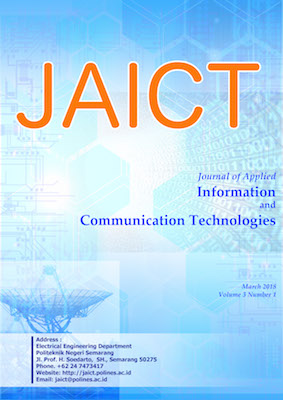Modulation Coding Scheme Performance Analysis (Mcs) Wireless 802.11ac Indoor At 5 Ghz Frequency In West And East Telecommunication Labs Politechnic State Of Semarang
DOI:
https://doi.org/10.32497/jaict.v3i1.1343Keywords:
MCS, RSSI, indoor, outdoorAbstract
Modulation Coding Scheme or MCS is a value that specifies the modulation, coding and number of spatial streams and produces a fixed rate data rate based on channel conditions and RSSI values received by the user. Modulation on MCS there are 5 kinds of BPSK, QPSK, 16 QAM, 64 QAM and 256 QAM. While the coding rate there are 4 kinds of ½, 2/3, ¾ and 5/6. MCS and RSSI. Changes can not be separated from wireless propagation that includes Large Scale Propagation and Small Scale Fading in particular the existence of obstacles in the form of objects and indoor or outdoor areas. Test results show that major changes to RSSI are influenced by indoor or outdoor areas. MCS changes are uncertain and not RSSI based. MCS and RSSI will change based on channel conditions.References
Goldsmith, A. (2005). Wireless Communication. Cambridge. [2] IEEE. (2009). IEEE Standart for Information Technology-Telecommunication and Iformation Exchange between System-Local Area NetworkSpecific Requirements. New York : IEEE Computer Society. [3] Kondoz, A. (2004). Digital Speech Coding for Low Bit Rate Communication System. Chicester : Jhon Wiley and Sons. [4] Sahu, P. W. Dual RSSI Trend Based Localization for Wireless Sensor Network.
Downloads
Published
Issue
Section
License
Authors who publish with this journal agree to the following terms:Authors retain copyright and grant the journal right of first publication with the work simultaneously licensed under a Creative Commons Attribution License that allows others to share the work with an acknowledgement of the work's authorship and initial publication in this journal.
Authors are able to enter into separate, additional contractual arrangements for the non-exclusive distribution of the journal's published version of the work (e.g., post it to an institutional repository or publish it in a book), with an acknowledgement of its initial publication in this journal.
Authors are permitted and encouraged to post their work online (e.g., in institutional repositories or on their website) prior to and during the submission process, as it can lead to productive exchanges, as well as earlier and greater citation of published work (See The Effect of Open Access).






